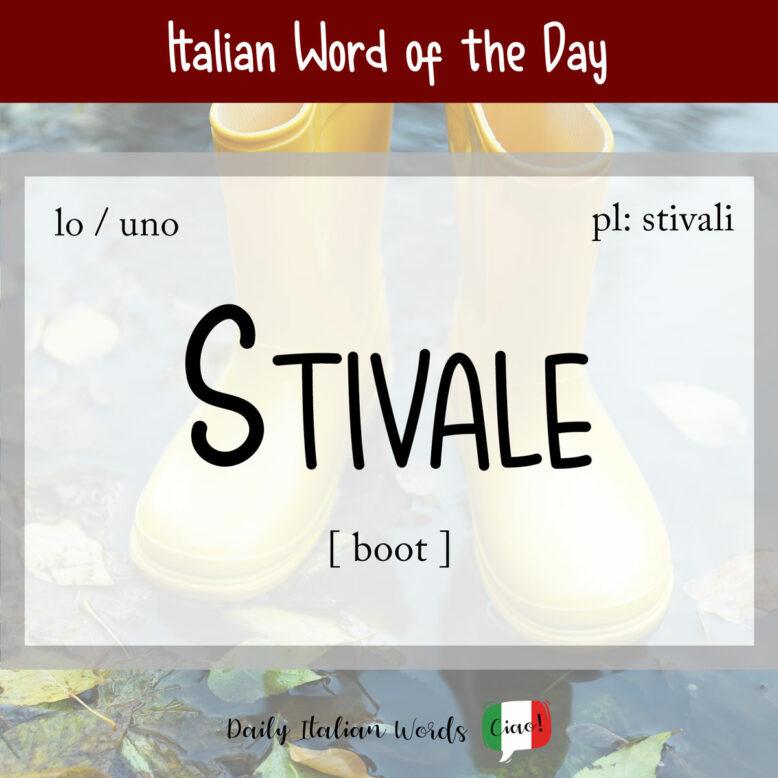One of my son’s favourite pastimes, like many kids his age, is jumping in muddy puddles (pozzanghere). Unfortunately, he’ll sometimes run into a puddle even without his boots (stivali) on!
stivale
boot

According to Treccani, the origin of stivale dates back to Old French estival, but beyond that, its etymology is uncertain. However, Devoto-Oli suggests that it might come from the Old French estive, meaning ‘leg‘ or ‘fipple flute,’ which in turn derives from the Latin stipa (“stalk of straw”).
Stivale is a masculine non and takes the following articles:
- lo stivale = the boot
- uno stivale = a boot
- gli stivali = the boots
- degli stivali = some boots
A stivale can be defined as a sturdy item of footwear that sits somewhere above the ankle and usually below the knee. There are many different kinds of stivali but here is a handful of the most popular:
- stivali di gomma = rubber boots / Wellingtons
- stivali di pelle / cuoio = leather boots
- stivali da caccia = hunting boots
- stivali da pesca = fishing boots
- stivali da equitazione = riding boots
- stivali da cowboy = cowboy boots
I tuoi stivali sono molto carini. Dove li hai comprati?
Your boots are really nice. Where did you buy them?
The most important parts of a stivale include il tacco (the heel), la punta (the toe), la suola (the sole), i lacci (the laces), la linguetta (the tongue), il gambale (the shaft) and i fori per i lacci (the eyelets).
Here are a few verbs you will often see used with stivale in everyday conversation:
- mettersi gli stivali = to put on one’s boots
- togliersi gli stivali = to take off one’s boots
- indossare gli stivali = to wear boots
- sfilare gli stivali = to take off one’s boots
- lucidare gli stivali = to polish one’s boots
Mettiti gli stivali – sta piovendo!
Put on your boots – it’s raining!

What about low ankle boots or booties? These are known by the diminutive stivaletto, with the -etto ending meaning “small.”
In English, we often refer to Italian peninsula as the Italian Boot due to the fact that its shape resembles a boot with a long heel (tacco). The same name can be used in Italian – lo Stivale. (For those interested in linguistics, the substitution of an epithet, such as stivale, for a proper name, such as Italia, is known as antonomasia!)

Did you know that…?
Long leather boots reaching the thighs first came into fashion in the 15th and 16th century, but were worn exclusively by men. It was actually a criminal offence (un reato) for women to wear them!
Idiomatic expressions featuring ‘stivale’
Dei miei stivali
Literal translation: of my boots
English meaning: an old-fashioned expression meaning good for nothing, worthless, a poor excuse for something (e.g. idraulico dei miei stivali = a poor excuse for a plumber)
Lustrare gli stivali a qualcuno
Literal translation: to shine someone’s boots
English meaning: to butter up someone
Rompere gli stivali a qualcuno
Literal translation: to break someone’s boots
English meaning: to annoy someone, get on someone’s nerves (a less common alternative to rompere le scatole a qualcuno, with scatole meaning boxes)
Heather Broster is a graduate with honours in linguistics from the University of Western Ontario. She is an aspiring polyglot, proficient in English and Italian, as well as Japanese, Welsh, and French to varying degrees of fluency. Originally from Toronto, Heather has resided in various countries, notably Italy for a period of six years. Her primary focus lies in the fields of language acquisition, education, and bilingual instruction.


